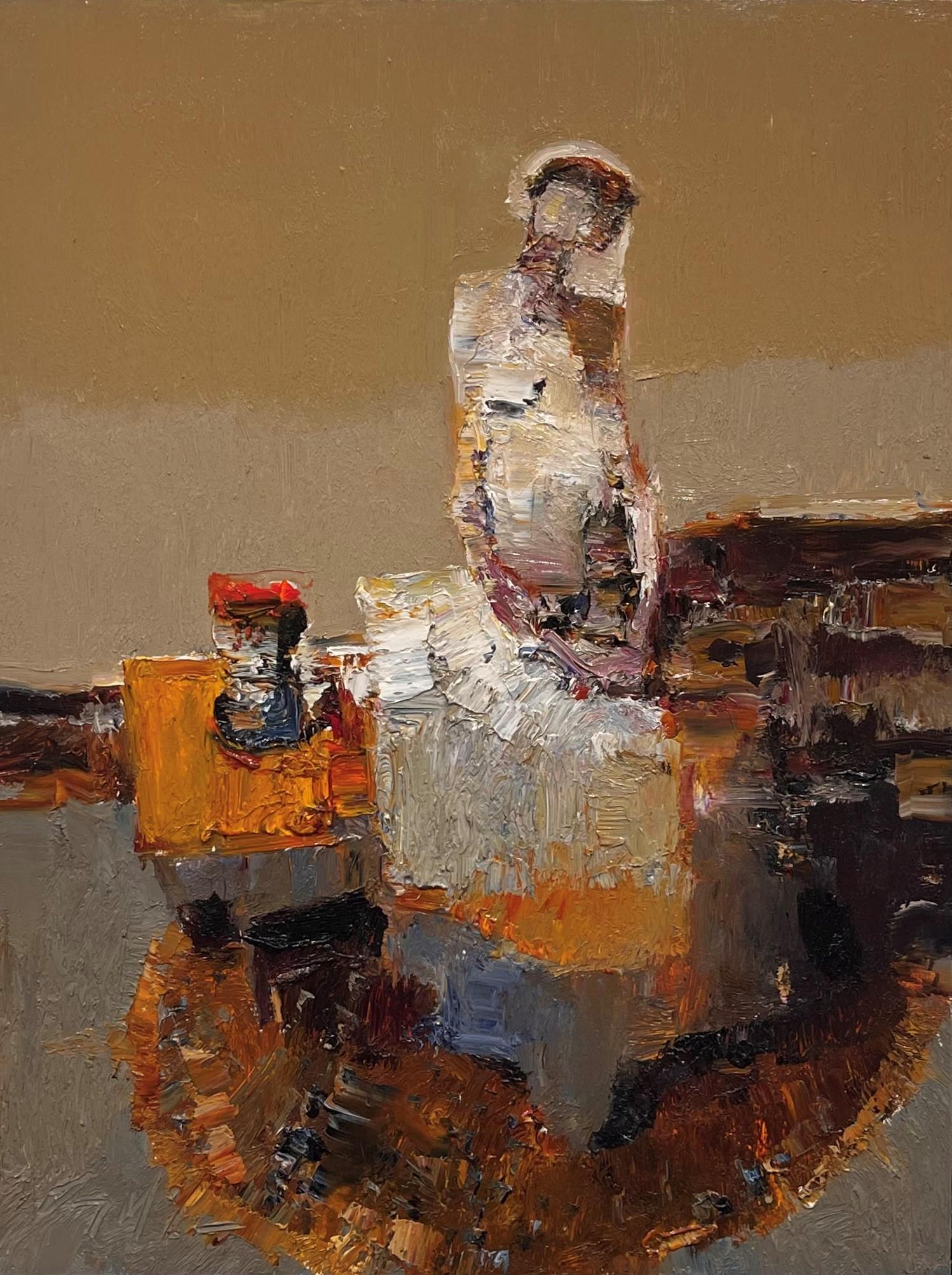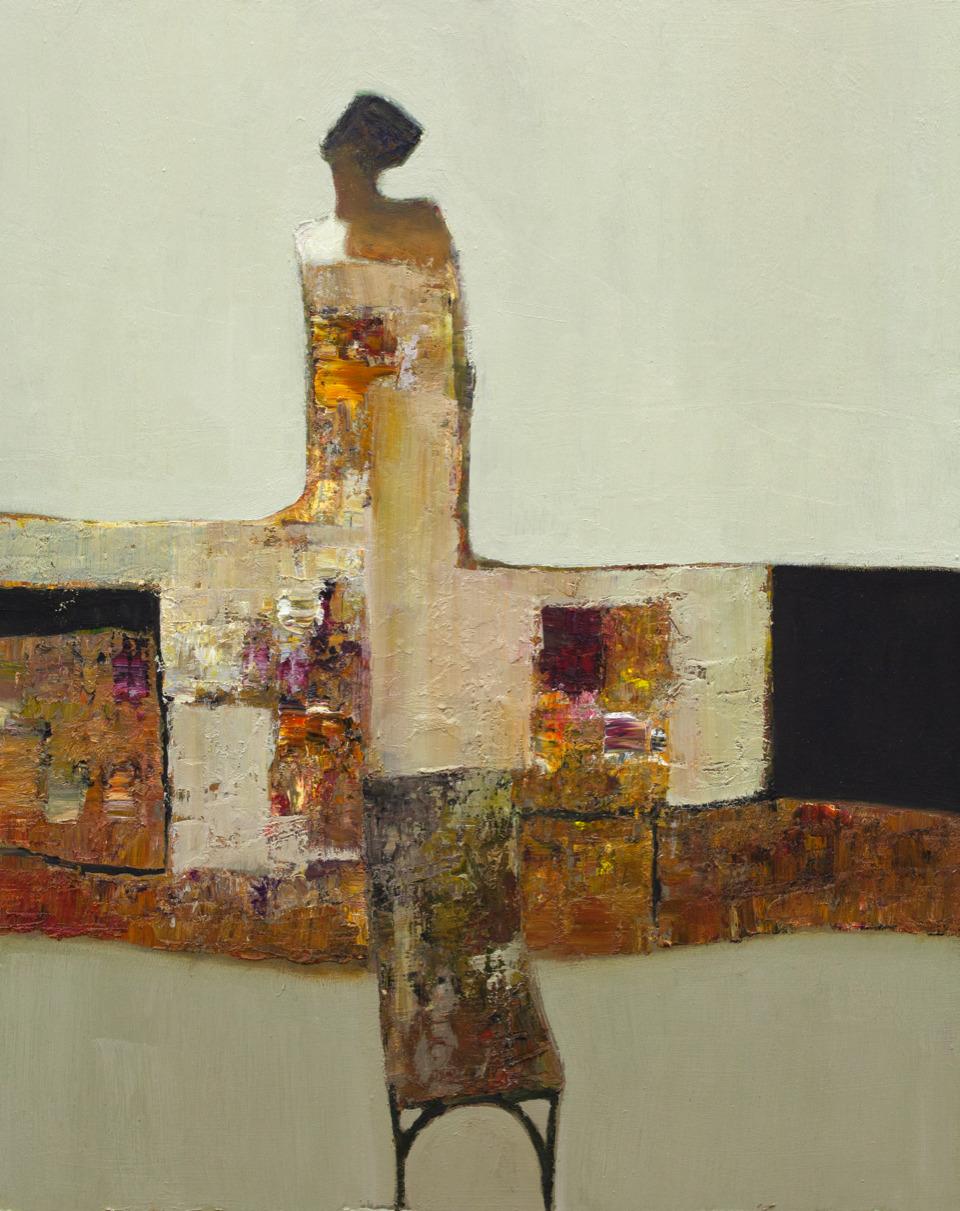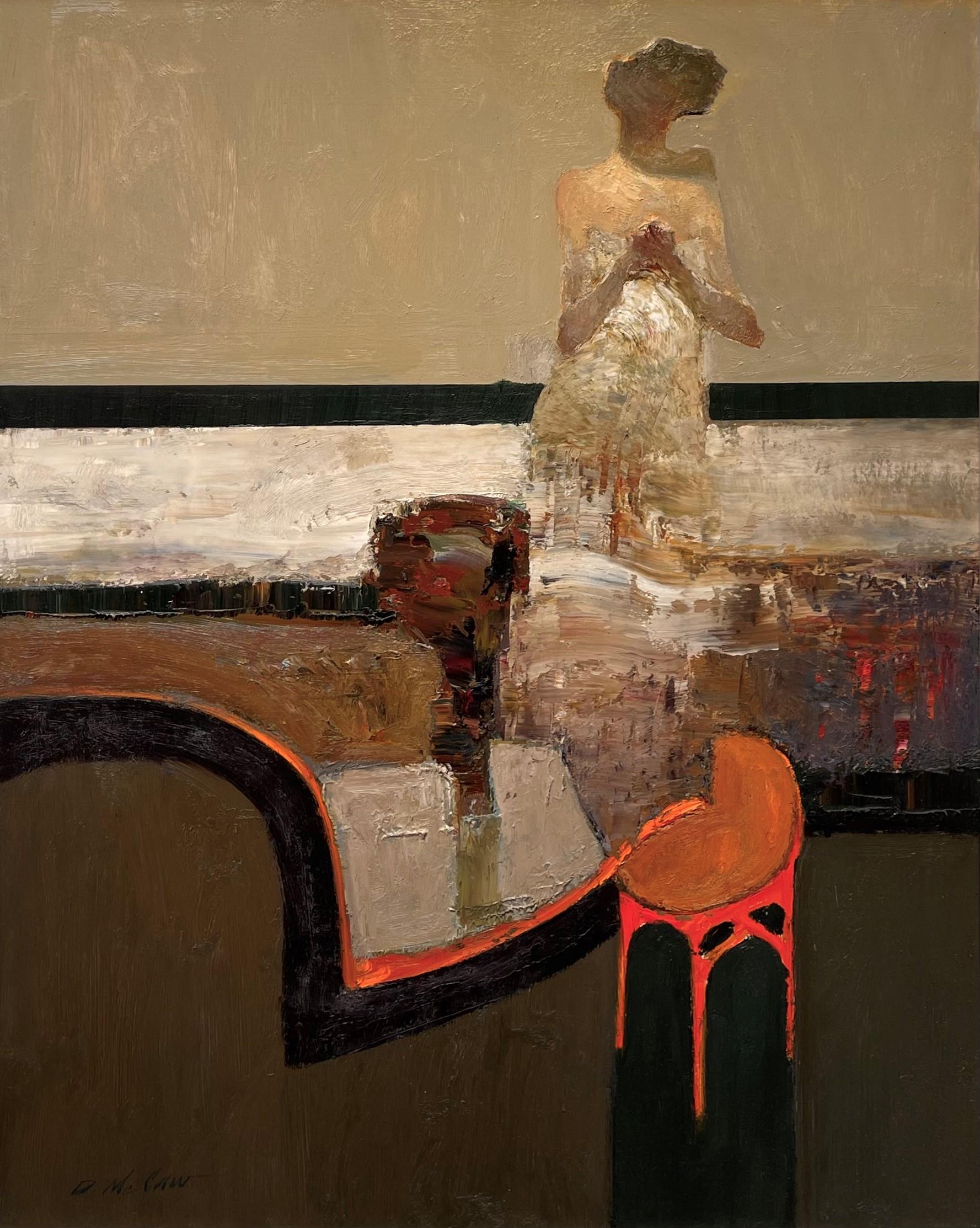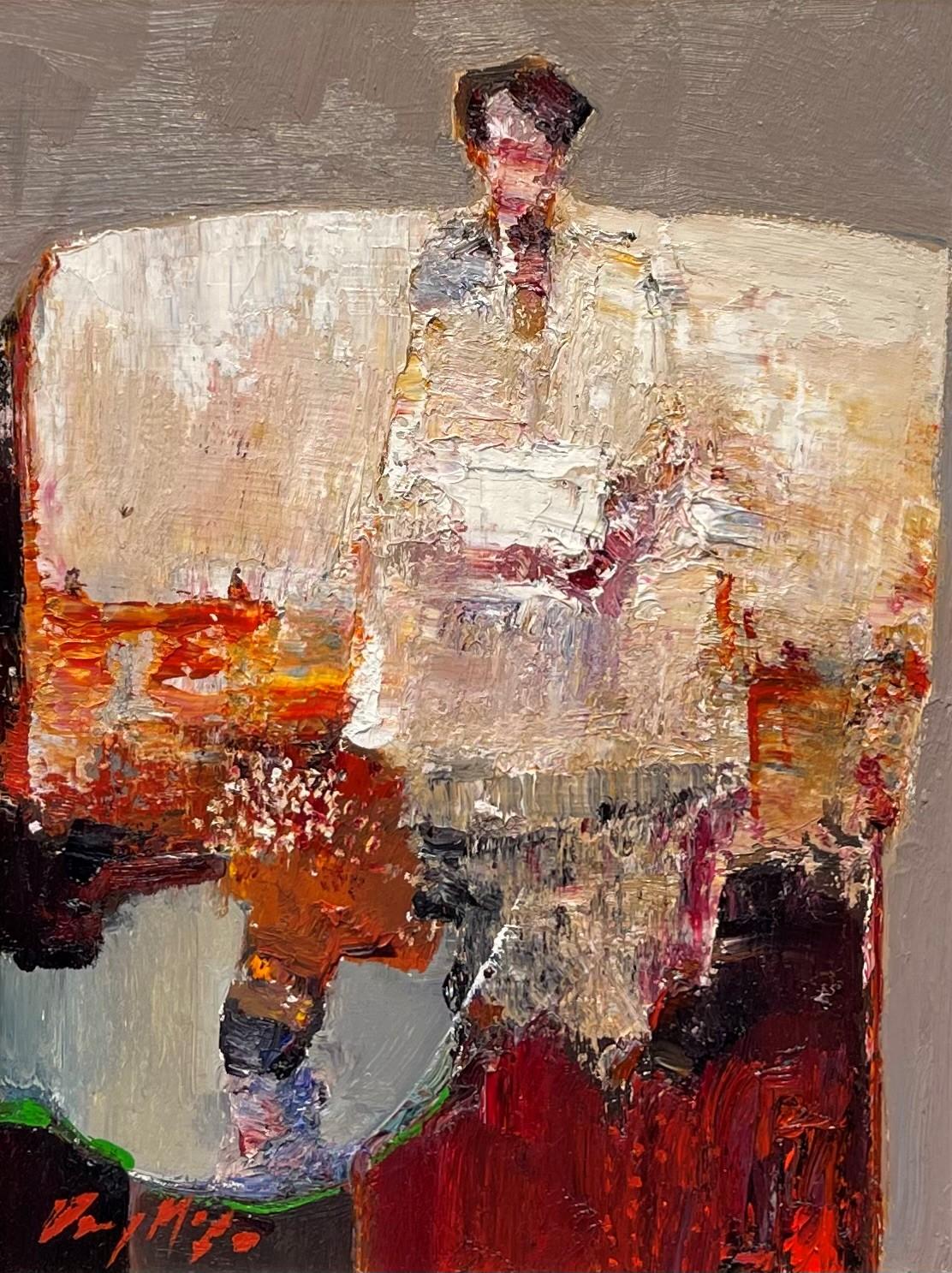Want more images or videos?
Request additional images or videos from the seller
1 of 7
Josef Zenk“Woman on the Rocks”
About the Item
Jim’s of Lambertville is proud to offer this artwork by:
Josef Zenk (1904-2000)
Josef Zenk was born in New York City in 1904. After graduating from high school, he studied for three years at the National Academy of Design, followed by further studies at the Art Students League in New York.
In 1926, Zenk moved to Utica, New York, where we he began to produce landscape, figurative, and still life paintings. He was part of a small community of artists who, in 1927 and 1928, organized exhibitions with many of the leading American painters, including Edward Hopper, Charles Sheeler, and Ernest Fiene. In 1930 he was granted a full scholarship to study at the Munson Williams Proctor Institute in Utica, where he later became an instructor until World War II. While there, an exhibition of his work produced the greatest attendance of any show at the institution of that year. In 1942, “Zuni” by Zenk became the first work purchased by the Munson Williams Proctor Institute for its Central New York Artists Collection.
After service in the Armed Forces from 1942 to 1945, Zenk left Utica and moved his studio to Palisades Park, New Jersey. Under the new G.I. Bill, he began to study at the New School in New York City. Along with Louis Schanker, a prominent woodcut artist and teacher at the New School, Zenk and a small group of printmakers formed “Studio 74” for the purpose of exhibiting their color woodblock prints. The group received immediate critical attention. The New York Times described the work of Josef Zenk as “particularly admirable”. One of his prints, “The Kiss”, was chosen in 1949 as one of the “best prints of the year” and was exhibited in the National Exhibition of Prints held at the Library of Congress in Washington D.C.
Zenk moved to Bucks County, Pennsylvania in the late 1940s, living in Upper Black Eddy, a town along the Delaware River, ten miles north of New Hope. He maintained a studio in Palisades Park for a while after the move, before eventually working full time from his studio in Pennsylvania. Zenk remained active painting and making woodblock prints, while also teaching art classes. He resided in Bucks County until the end of his life at the age of ninety-six.
Like several other important Pennsylvania and New Jersey artists, the works of Josef Zenk were only recently rediscovered and brought to light. For the remaining thirty-five years of his life, he chose a somewhat reclusive lifestyle, away from the frenetic art scene.
Josef Zenk’s works have been shown in over twenty-seven museums, including the San Francisco Museum of Art, the Brooklyn Museum, the Newark Museum, the Seattle Museum of Art, and the National Academy of Design. Through the many exhibitions during his career, Zenk progressed from stylized realism in landscape and figurative painting to a powerful modernist and abstract style with a strong sense of personal expression.
Source: New Hope for American Art, James Alterman
- Creator:
- Dimensions:Height: 28 in (71.12 cm)Width: 24 in (60.96 cm)Depth: 2 in (5.08 cm)
- More Editions & Sizes:Framed Size 28" x 24"Price: $18,125
- Medium:
- Movement & Style:
- Period:
- Condition:
- Gallery Location:Lambertville, NJ
- Reference Number:
About the Seller
5.0
Vetted Seller
These experienced sellers undergo a comprehensive evaluation by our team of in-house experts.
Established in 1997
1stDibs seller since 2014
36 sales on 1stDibs
Typical response time: 6 hours
- ShippingRetrieving quote...Ships From: Lambertville, NJ
- Return PolicyThis item cannot be returned.
More From This SellerView All
- “Woman in Black”By Vaclav VytlacilLocated in Lambertville, NJJim’s of Lambertville is proud to offer this artwork by: Vaclav Vytlacil (1892-1984) He was born to Czechoslovakian parents in 1892 in New York City. Living in Chicago as a youth, he took classes at the School of the Art Institute of Chicago, returning to New York when he was 20. From 1913 to 1916, he enjoyed a scholarship from the Art Students League, and worked with John C. Johansen (a portraitist whose expressive style resembled that of John Singer Sargent), and Anders Zorn. He accepted a teaching position at the Minneapolis School of Art in 1916, remaining there until 1921. This enabled him to travel to Europe to study Cézanne’s paintings and works of the Old Masters. He traveled to Paris, Prague, Dresden, Berlin, and Munich seeking the works of Titian, Cranach, Rembrandt, Veronese, and Holbein, which gave him new perspective. Vytlacil studied at the Royal Academy of Art in Munich, settling there in 1921. Fellow students were Ernest Thurn and Worth Ryder, who introduced him to famous abstractionist Hans Hofmann. He worked with Hofmann from about 1922 to 1926, as a student and teaching assistant. During the summer of 1928, after returning to the United States, Vytlacil gave lectures at the University of California, Berkeley, on modern European art. Soon thereafter, he became a member of the Art Students League faculty. After one year, he returned to Europe and successfully persuaded Hofmann to teach at the League as well. He spent about six years in Europe, studying the works of Matisse, Picasso, and Dufy. In 1935, he returned to New York and became a co-founder of the American Abstract Artists group in 1936. He later had teaching posts at Queens College in New York; the College of Arts and Crafts in Oakland, California; Black Mountain College in North Carolina; and the Art Students League. His paintings exhibit a clear inclination toward modernism. His still lives and interiors from the 1920s indicate an understanding of the art of Cézanne. In the 1930s, his works displayed two very different kinds of art at the same time. His cityscapes and landscapes combine Cubist-inspired spatial concerns with an expressionistic approach to line and color. Vytlacil also used old wood, metal, cork, and string in constructions, influenced by his friend and former student, Rupert Turnbull. He eventually ceased creating constructions as he considered them too limiting. The spatial challenges of painting were still his preference. During the 1940s and 1950s, his works indicated a sense of spontaneity not felt in his earlier work. He married Elizabeth Foster in Florence, Italy, in 1927 and they lived and worked in Positano, Italy for extended periods of time. Later on, they divided their time between homes in Sparkill, New York and Chilmark, Massachusetts, where Vyt, as he was affectionately called, taught at the Martha's Vineyard Art...Category
1960s Abstract Expressionist Figurative Paintings
MaterialsOil, Board
- "Roman Bath" Series (2/3)By Vaclav VytlacilLocated in Lambertville, NJJim’s of Lambertville is proud to offer this artwork by: Vaclav Vytlacil (1892-1984) He was born to Czechoslovakian parents in 1892 in New York City. Living in Chicago as a youth, he took classes at the School of the Art Institute of Chicago, returning to New York when he was 20. From 1913 to 1916, he enjoyed a scholarship from the Art Students League, and worked with John C. Johansen (a portraitist whose expressive style resembled that of John Singer Sargent), and Anders Zorn. He accepted a teaching position at the Minneapolis School of Art in 1916, remaining there until 1921. This enabled him to travel to Europe to study Cézanne’s paintings and works of the Old Masters. He traveled to Paris, Prague, Dresden, Berlin, and Munich seeking the works of Titian, Cranach, Rembrandt, Veronese, and Holbein, which gave him new perspective. Vytlacil studied at the Royal Academy of Art in Munich, settling there in 1921. Fellow students were Ernest Thurn and Worth Ryder, who introduced him to famous abstractionist Hans Hofmann. He worked with Hofmann from about 1922 to 1926, as a student and teaching assistant. During the summer of 1928, after returning to the United States, Vytlacil gave lectures at the University of California, Berkeley, on modern European art. Soon thereafter, he became a member of the Art Students League faculty. After one year, he returned to Europe and successfully persuaded Hofmann to teach at the League as well. He spent about six years in Europe, studying the works of Matisse, Picasso, and Dufy. In 1935, he returned to New York and became a co-founder of the American Abstract Artists group in 1936. He later had teaching posts at Queens College in New York; the College of Arts and Crafts in Oakland, California; Black Mountain College in North Carolina; and the Art Students League. His paintings exhibit a clear inclination toward modernism. His still lives and interiors from the 1920s indicate an understanding of the art of Cézanne. In the 1930s, his works displayed two very different kinds of art at the same time. His cityscapes and landscapes combine Cubist-inspired spatial concerns with an expressionistic approach to line and color. Vytlacil also used old wood, metal, cork, and string in constructions, influenced by his friend and former student, Rupert Turnbull. He eventually ceased creating constructions as he considered them too limiting. The spatial challenges of painting were still his preference. During the 1940s and 1950s, his works indicated a sense of spontaneity not felt in his earlier work. He married Elizabeth Foster in Florence, Italy, in 1927 and they lived and worked in Positano, Italy for extended periods of time. Later on, they divided their time between homes in Sparkill, New York and Chilmark, Massachusetts, where Vyt, as he was affectionately called, taught at the Martha's Vineyard Art...Category
20th Century Abstract Impressionist Abstract Paintings
MaterialsOil, Board
- "After Work"By Vaclav VytlacilLocated in Lambertville, NJJim’s of Lambertville is proud to offer this artwork. Signed lower right Vaclav Vytlacil (1892-1984) He was born to Czechoslovakian parents in 1892 in New York City. Living in C...Category
20th Century Abstract Expressionist Abstract Paintings
MaterialsOil, Board
- "The Evening Crowd, Manhattan"By Vaclav VytlacilLocated in Lambertville, NJJim’s of Lambertville is proud to offer this artwork by: Vaclav Vytlacil (1892-1984) He was born to Czechoslovakian parents in 1892 in New York City. Living in Chicago as a youth, he took classes at the School of the Art Institute of Chicago, returning to New York when he was 20. From 1913 to 1916, he enjoyed a scholarship from the Art Students League, and worked with John C. Johansen (a portraitist whose expressive style resembled that of John Singer Sargent), and Anders Zorn. He accepted a teaching position at the Minneapolis School of Art in 1916, remaining there until 1921. This enabled him to travel to Europe to study Cézanne’s paintings and works of the Old Masters. He traveled to Paris, Prague, Dresden, Berlin, and Munich seeking the works of Titian, Cranach, Rembrandt, Veronese, and Holbein, which gave him new perspective. Vytlacil studied at the Royal Academy of Art in Munich, settling there in 1921. Fellow students were Ernest Thurn and Worth Ryder, who introduced him to famous abstractionist Hans Hofmann. He worked with Hofmann from about 1922 to 1926, as a student and teaching assistant. During the summer of 1928, after returning to the United States, Vytlacil gave lectures at the University of California, Berkeley, on modern European art. Soon thereafter, he became a member of the Art Students League faculty. After one year, he returned to Europe and successfully persuaded Hofmann to teach at the League as well. He spent about six years in Europe, studying the works of Matisse, Picasso, and Dufy. In 1935, he returned to New York and became a co-founder of the American Abstract Artists group in 1936. He later had teaching posts at Queens College in New York; the College of Arts and Crafts in Oakland, California; Black Mountain College in North Carolina; and the Art Students League. His paintings exhibit a clear inclination toward modernism. His still lives and interiors from the 1920s indicate an understanding of the art of Cézanne. In the 1930s, his works displayed two very different kinds of art at the same time. His cityscapes and landscapes combine Cubist-inspired spatial concerns with an expressionistic approach to line and color. Vytlacil also used old wood, metal, cork, and string in constructions, influenced by his friend and former student, Rupert Turnbull. He eventually ceased creating constructions as he considered them too limiting. The spatial challenges of painting were still his preference. During the 1940s and 1950s, his works indicated a sense of spontaneity not felt in his earlier work. He married Elizabeth Foster in Florence, Italy, in 1927 and they lived and worked in Positano, Italy for extended periods of time. Later on, they divided their time between homes in Sparkill, New York and Chilmark, Massachusetts, where Vyt, as he was affectionately called, taught at the Martha's Vineyard Art...Category
1930s Abstract Abstract Paintings
MaterialsCanvas, Oil
- "Manhattan Night Life"By Vaclav VytlacilLocated in Lambertville, NJJim’s of Lambertville is proud to offer this artwork by: Vaclav Vytlacil (1892-1984) He was born to Czechoslovakian parents in 1892 in New York City. Living in Chicago as a youth, he took classes at the School of the Art Institute of Chicago, returning to New York when he was 20. From 1913 to 1916, he enjoyed a scholarship from the Art Students League, and worked with John C. Johansen (a portraitist whose expressive style resembled that of John Singer Sargent), and Anders Zorn. He accepted a teaching position at the Minneapolis School of Art in 1916, remaining there until 1921. This enabled him to travel to Europe to study Cézanne’s paintings and works of the Old Masters. He traveled to Paris, Prague, Dresden, Berlin, and Munich seeking the works of Titian, Cranach, Rembrandt, Veronese, and Holbein, which gave him new perspective. Vytlacil studied at the Royal Academy of Art in Munich, settling there in 1921. Fellow students were Ernest Thurn and Worth Ryder, who introduced him to famous abstractionist Hans Hofmann. He worked with Hofmann from about 1922 to 1926, as a student and teaching assistant. During the summer of 1928, after returning to the United States, Vytlacil gave lectures at the University of California, Berkeley, on modern European art. Soon thereafter, he became a member of the Art Students League faculty. After one year, he returned to Europe and successfully persuaded Hofmann to teach at the League as well. He spent about six years in Europe, studying the works of Matisse, Picasso, and Dufy. In 1935, he returned to New York and became a co-founder of the American Abstract Artists group in 1936. He later had teaching posts at Queens College in New York; the College of Arts and Crafts in Oakland, California; Black Mountain College in North Carolina; and the Art Students League. His paintings exhibit a clear inclination toward modernism. His still lives and interiors from the 1920s indicate an understanding of the art of Cézanne. In the 1930s, his works displayed two very different kinds of art at the same time. His cityscapes and landscapes combine Cubist-inspired spatial concerns with an expressionistic approach to line and color. Vytlacil also used old wood, metal, cork, and string in constructions, influenced by his friend and former student, Rupert Turnbull. He eventually ceased creating constructions as he considered them too limiting. The spatial challenges of painting were still his preference. During the 1940s and 1950s, his works indicated a sense of spontaneity not felt in his earlier work. He married Elizabeth Foster in Florence, Italy, in 1927 and they lived and worked in Positano, Italy for extended periods of time. Later on, they divided their time between homes in Sparkill, New York and Chilmark, Massachusetts, where Vyt, as he was affectionately called, taught at the Martha's Vineyard Art...Category
1930s Abstract Expressionist Abstract Paintings
MaterialsCanvas, Oil
- "Seriously!"By James LechayLocated in Lambertville, NJSigned lower right Jim’s of Lambertville is proud to offer this artwork by: Rex Ashlock (1918 – 1999) Born in Spokane, Washington in 1918 Rex Ashlock was known for his abstract, f...Category
20th Century Abstract Abstract Paintings
MaterialsCanvas, Oil
You May Also Like
- "Red Flower", Oil PaintingBy Danny McCawLocated in Denver, CODanny McCaw's (US based) "Untitled" is an original, handmade oil painting with impasto brushstrokes that depicts an ambiguous figure of white and grey sitting in an interior of grey....Category
2010s Abstract Impressionist Abstract Paintings
MaterialsOil, Board
- "Indelible, " Oil PaintingLocated in Denver, CODan McCaw's (US based) "Indelible" is an original, handmade oil painting that depicts an abstracted dark patterned figure standing in a patterned interior setting. Artist Statement...Category
2010s Abstract Expressionist Abstract Paintings
MaterialsBoard, Oil
- "Observation" 48" x 36" Oil PaintingLocated in Denver, CODan McCaw's (US based) "Observation" is an original, handmade oil painting that depicts two abstracted figures standing together as the rest of the composition fades into green and w...Category
2010s Abstract Expressionist Abstract Paintings
MaterialsOil, Board
- "Untitled, " Oil PaintingLocated in Denver, CODan McCaw's (US based) "Untitled" is an original, handmade oil painting that depicts an abstracted figure standing in a striped interior setting. Artist Statement: Born: 1942 A s...Category
2010s Abstract Expressionist Abstract Paintings
MaterialsOil, Board
- "The Dancers" Oil PaintingBy Danny McCawLocated in Denver, CODanny McCaw's (US based) "The Dancers" is an original, handmade oil painting with impasto brushstrokes that depicts two ambiguous human figures of white and grey with a white and mar...Category
2010s Abstract Impressionist Abstract Paintings
MaterialsOil, Board
- "Radiance" Abstracted Figure Oil PaintingBy Danny McCawLocated in Denver, CODanny McCaw's (US based) "RAdiance" is an original, handmade oil painting with impasto brushstrokes that depicts an ambiguous figure of white and grey sitting in an interior of grey ...Category
2010s Abstract Impressionist Abstract Paintings
MaterialsOil, Board
Recently Viewed
View AllMore Ways To Browse
The Other Woman
Strong Woman
High On Hope
Woman Park
Vintage Working Woman
The Group Of Seven
Woman In Park Painting
1940s Woman
Strong Vintage Woman
Strong Woman Vintage
Lighted Rocks
Oil Paintings Of Rocks
Oil On Board Print
Small Woodblock
Bucks County Pennsylvania
Delaware River
Bucks County Vintage
Studio Twenty Seven





